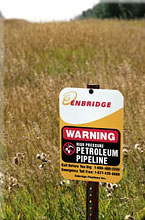Overview
Rights-of-way (ROW) describe the property, or easement, that pipeline operators secure to install and maintain transmission pipelines. Operators generally obtain ROW by purchasing the property, by mutual negotiated agreement with a landowner, or through court-ordered condemnation procedures. Condemnation procedures are only carried out when specific types of pipelines are deemed by the courts to be necessary for public convenience.
Easement Agreements
Agreements typically specify the rights of the pipeline operator with respect to the property, as well as the ongoing rights of the landowner. Additionally, ROW agreements may address issues such as:
- Single or multiple pipeline rights
- Defined ROW width, which can vary from as small as the width of the pipeline to 50-feet or more
- Rights for above ground facilities attached to the pipeline, such as valves
- Pipeline repair or modification constraints or considerations
- Payment for original and continued use of the ROW
- Damage award amounts appropriate for the property owner associated with original construction or future repairs/modifications
- Access requirements for pipeline personnel
- Requirements for pipeline removal upon abandonment of the pipeline
Special Considerations

A ROW is ordinarily sufficient for day-to-day operations of a pipeline, but is often insufficient for situations where pipeline repairs or expansions are planned. In such cases, the pipeline operator often has to renegotiate with a property owner for additional permanent and/or temporary work space.
Pipeline operators generally try to keep the ROW as free of physical encumbrances as possible in order to assure reasonable and frequent visual inspections of the pipeline from the air and ground. In addition, a clear ROW helps ensure ease of access for repair excavations.
Pipeline operators generally try to keep the ROW free of physical encumbrance to assure reasonable and frequent visual inspections of the pipeline. In addition, a clear ROW helps ensure ease of access for repair excavations.
These concerns must be balanced with the wishes of the landowner to maintain options for the ROW, including using the land for crops, grazing, parking and other uses. Limitations on the landowner often include prohibitions against the installation of buildings, pools, trees and other physical structures.
Residential and commercial development in once-rural areas is encroaching on pipeline ROWs with increasing frequency. Encroachment implies safety concerns for local residents and for the physical integrity of the pipeline itself. To help prevent encroachment and excavation-related damage to pipelines, operators are required to post pipeline markers clearly and frequently along the length of the ROW. They must also communicate with residents along the ROW and establish liaison with local government and emergency officials.
Additional information:
Click here for additional information about pipeline markers.
